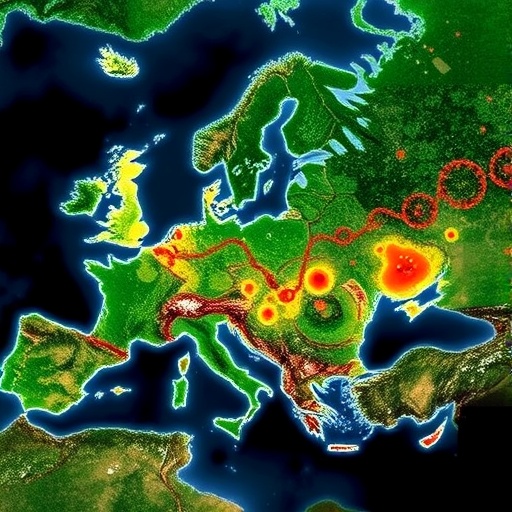In a monumental stride in understanding the ancient microbial world, researchers have unveiled a comprehensive analysis of ancient DNA (aDNA) shotgun sequencing data derived from over 1,300 ancient human individuals spanning Eurasia. This unprecedented dataset offers profound insights into the spatiotemporal distribution of human pathogens dating back thousands of years, illuminating the dynamics of infectious diseases that once shaped human history. The study deftly combines cutting-edge computational methods and rigorous authentication techniques to uncover traces of ancient microbial DNA with remarkable sensitivity and specificity.
Central to the research is the meticulous screening for authentic ancient microbial DNA. The investigative team employed a hybrid computational workflow incorporating k-mer-based taxonomic classification, precise read mapping, and multiple authentication layers tailored to detect genuine aDNA signals. Initial taxonomic assignments were performed using KrakenUniq against expansive genomic databases covering bacterial, viral, archaeal, and protozoan genomes. The strategy included a specialized reclassification run focused exclusively on viral genomes, enhancing the sensitivity toward elusive ancient viruses that often evade detection due to their low abundance.
The methodology carefully prioritizes genera known to harbor human pathogens, setting thresholds that balance inclusivity with computational tractability. By narrowing focus to genera containing multiple pathogenic species, alongside viral and protozoan groups, the researchers ensured comprehensive yet efficient screening. Each genus showing evidence of presence — designated by a minimum count of unique k-mers — underwent species-level read alignment against representative reference genomes using bowtie2 with stringent parameters to safeguard precision. Subsequent duplicate marking and high-quality mapping filters further refined the dataset, culminating in detailed damage pattern analyses through metaDMG software.
.adsslot_Pzl0dyJY8q{ width:728px !important; height:90px !important; }
@media (max-width:1199px) { .adsslot_Pzl0dyJY8q{ width:468px !important; height:60px !important; } }
@media (max-width:767px) { .adsslot_Pzl0dyJY8q{ width:320px !important; height:50px !important; } }
ADVERTISEMENT
Authenticating ancient microbial DNA presented unique challenges addressed through multifaceted summary statistics that simultaneously assess similarity to reference genomes, characteristic aDNA damage patterns, and evenness of genomic coverage. Metrics such as average edit distance, average nucleotide identity (ANI), and the quantity of unique k-mers mapped provide foundational evidence for species-level accuracy. Complementary damage indicators—including nucleotide substitution rates at read termini and Bayesian estimators of damage prevalence—distinguish ancient sequences from modern contamination. Moreover, the distribution uniformity of mapped reads, quantified by coverage breadth and relative entropy measures, serves as a crucial quality benchmark, reinforcing the fidelity of identified hits.
Crucially, the study embraces a rigorous filtering schema to isolate high-confidence ancient microbial signatures. Putative hits must surpass multiple criteria: minimum read counts, significant terminal deamination rates (both 5’ C→T and 3’ G→A substitutions), a minimum ratio of observed to expected coverage, high relative entropy of read start positions, elevated ANI values, and top ranks in unique k-mer abundance. For viral species, these thresholds are carefully relaxed where genome size or biological peculiarities warrant, ensuring the retention of credible viral detections often hindered by their compact genetic architectures.
This conservative, yet effective approach prioritizes singular best species assignments per sample and genus, mitigating false positives driven by cross-mapping events inherent in closely related microbial taxa. To further bolster confidence, especially in low coverage scenarios, the team performed BLASTn analysis of candidate reads against the comprehensive nucleotide database, quantifying congruence at the genus and species levels. This step provides an orthogonal layer of validation, enhancing the robustness of ancient microbial identifications.
Beyond empirical data, the researchers conducted extensive in silico simulations to probe detection limits and validate their workflow. By generating millions of damaged sequence reads from nine pathogen genomes absent from reference databases, they emulated realistic ancient DNA fragmentation and damage profiles. Downsampling experiments demonstrated the pipeline’s capacity to reliably detect pathogens present at very low abundance, underscoring the method’s sensitivity in challenging ancient metagenomic contexts.
The study’s innovative use of topic modeling techniques elucidated broader taxonomic co-occurrence patterns within the ancient microbial communities. Applying the fastTopics R package to k-mer count matrices, the team distilled dominant microbial assemblages, revealing underlying ecological and pathological structures. These analyses provided a refined lens through which to interpret complex mixed DNA signals inherent in ancient samples, illuminating consistent microbial “signatures” associated with different ancient environments and host conditions.
Recognizing the diverse origins of microbial DNA in ancient individuals, the researchers classified identified microbes into three fundamental categories: environmental taxa representing soil and necrobiome communities; members of the oral microbiome, encompassing both commensals and opportunistic pathogens; and bona fide pathogens, further sub-divided by transmission mode—anthroponotic, vector-borne, or zoonotic. This structured framework enabled nuanced interpretations of ancient infection dynamics and microbial ecology within human populations.
Geospatial visualization of the findings leveraged state-of-the-art statistical computing tools and public geospatial datasets, refining the contextualization of pathogen distributions across diverse terrain features. This spatial dimension underscored associations between environmental variables and microbial incidence, complementing the temporal analyses to produce a rich, multidimensional portrait of ancient pathogen landscapes.
Together, these integrative methods and expansive datasets constitute a landmark contribution to paleomicrobiology, blending rigorous computational biology with archaeological genomics to chart the ancient interaction between humans and their microbial companions. The study not only provides an ancient record of infectious disease but also establishes a versatile framework adaptable to future metagenomic and paleopathological investigations.
Subject of Research: The spatiotemporal distribution and authentication of ancient microbial DNA in ancient human populations across Eurasia.
Article Title: The spatiotemporal distribution of human pathogens in ancient Eurasia
Article References:
Sikora, M., Canteri, E., Fernandez-Guerra, A. et al. The spatiotemporal distribution of human pathogens in ancient Eurasia. Nature (2025). https://doi.org/10.1038/s41586-025-09192-8
Image Credits: AI Generated
Tags: ancient DNA analysisancient human pathogensancient viruses detectioncomputational methods in microbiologyEurasian pathogens studyhuman health and historyhybrid computational workflowinfectious diseases historyk-mer taxonomic classificationmicrobial DNA sequencingmicrobial genome databasespathogen spatiotemporal distribution





